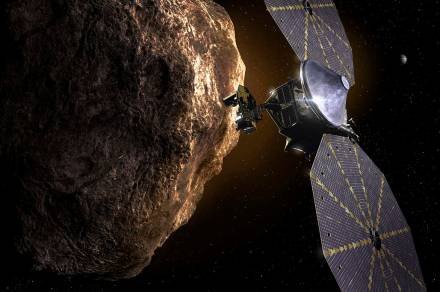NASA’s Lucy spacecraft is currently traveling through the solar system on its way to study the Trojan asteroids in the orbit of Jupiter. The original plan was for the mission to make its first close approach to an asteroid in 2025, but a new plan will see the spacecraft make a flyby of a bonus asteroid later this year.
The asteroid Lucy will pass by is tiny, at just 0.4 miles across, and is currently unnamed — it is referred to by its technical name, 1999 VD57. But it happens to be located close to the path Lucy is taking, and by making small adjustments to the its course Lucy will be able to come even closer.
“There are millions of asteroids in the main asteroid belt,” said a member of the Lucy team, Raphael Marschall of the Nice Observatory in France, who picked out the asteroid to be visited. “I selected 500,000 asteroids with well-defined orbits to see if Lucy might be traveling close enough to get a good look at any of them, even from a distance. This asteroid really stood out. Lucy’s trajectory as originally designed will take it within 40,000 miles of the asteroid, at least three times closer than the next closest asteroid.”
Lucy will begin making maneuvers in May this year to bring it within just 280 miles of the asteroid when it passes in November 2023. The team hopes that this extra flyby could be useful for checking that they can correctly point the cameras toward it using a new tracking system.
“In the past, most flyby missions have accounted for this uncertainty by taking a lot of images of the region where the asteroid might be, meaning low efficiency and lots of images of blank space,” said Hal Levison, Lucy principal investigator from the Southwest Research Institute. “Lucy will be the first flyby mission to employ this innovative and complex system to automatically track the asteroid during the encounter. This novel system will allow the team to take many more images of the target.”
Since its launch, Lucy has had problems with a stuck solar arrayand NASA recently announced that it would pause attempts to fully deploy the array as the spacecraft is now traveling away from the sun and getting colder. However, models predict that as the array is 98% deployed it will be strong enough to complete the mission as planned.
Today’s tech news, curated and condensed for your inbox
Check your inbox!
Please provide a valid email address to continue.
This email address is currently on file. If you are not receiving newsletters, please check your spam folder.
Sorry, an error occurred during subscription. Please try again later.
Editors’ Recommendations
- James Webb peers into icy cloud to learn about exoplanet formation
- One of James Webb’s four instruments is offline following error
- SpaceX takes big step toward first flight of most powerful rocket
- 30-year-old mission to study the magnetosphere comes to a close
- There’s an asteroid surprise in this week’s Hubble image








